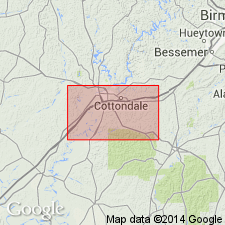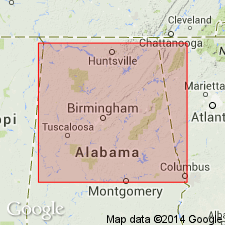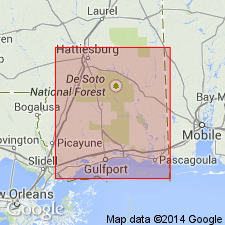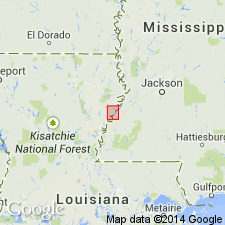
- Usage in publication:
-
- Coker formation*
- Modifications:
-
- Named
- Dominant lithology:
-
- Sand
- Clay
- Bentonite
- Gravel
- AAPG geologic province:
-
- Black Warrior basin
Summary:
Named as a formation in Tuscaloosa group. Named for Coker, Tuscaloosa Co., west-central AL. Consists of varying lithologies including 1) a basal strongly cross-bedded channel sand with an upper part locally finely laminated and containing macerated plant remains; 2) massive carbonaceous and varicolored clay containing nodules of granular siderite; locally clay occupies a channel which in places may extend to base of formation; 3) interbedded purple and gray mottled clay and highly cross-bedded and fine-grained micaceous yellow sand containing brecciated clay; 4) bentonite bed near base in one area; and 5) local occurrences of chert gravel which resemble gravel of overlying Gordo formation; gravels are tentatively assigned because of the strikingly abrupt and widespread appearance of gravel in the Gordo; further investigations may indicate that gravel and coarse sand should be reassigned to the Gordo. Thickness ranges from 150 to 250 ft. Overlies Eoline formation (new); underlies Gordo formation (new). Age is Late Cretaceous.
Source: GNU records (USGS DDS-6; Reston GNULEX).

- Usage in publication:
-
- Coker formation*
- Modifications:
-
- Revised
- AAPG geologic province:
-
- Black Warrior basin
Summary:
Coker formation is stratigraphically extended below to include all outcropping pre-Gordo sediments of the Tuscaloosa group except sediments designated Vick formation by Conant (1946), which may be Tuscaloosa in age. Coker thus consists regionally of a lower Eoline member and an upper unnamed member.
Source: GNU records (USGS DDS-6; Reston GNULEX).

- Usage in publication:
-
- Coker Formation*
- Modifications:
-
- Areal extent
- AAPG geologic province:
-
- Mid-Gulf Coast basin
Summary:
Coker Formation of Tuscaloosa Group extended into southeastern MS in the subsurface. Age is Late Cretaceous.
Source: GNU records (USGS DDS-6; Reston GNULEX).

- Usage in publication:
-
- Coker Formation
- Modifications:
-
- Areal extent
- AAPG geologic province:
-
- Gulf Coast basin
- Arkla basin
Summary:
Coker Formation of Tuscaloosa Group is present in the subsurface of east-central LA. Age is Late Cretaceous.
Source: GNU records (USGS DDS-6; Reston GNULEX).

- Usage in publication:
-
- Coker Formation*
- Modifications:
-
- Age modified
- AAPG geologic province:
-
- Mid-Gulf Coast basin
Summary:
Tuscaloosa Formation of eastern AL and western GA and Coker Formation of Tuscaloosa Group in western AL assigned to early Turonian. Gordo Formation of Tuscaloosa Group of possible late Turonian age.
Source: GNU records (USGS DDS-6; Reston GNULEX).

- Usage in publication:
-
- Coker Formation
- Modifications:
-
- Overview
- AAPG geologic province:
-
- Black Warrior basin
Summary:
Coker Formation of Tuscaloosa Group in west-central AL consists of light-colored very fine to medium micaceous sand, cross-bedded sand, varicolored micaceous clay, and a few thin gravel beds containing chert and quartz pebbles. Quartz and chert gravels at the base of the formation are composed of very fine pebbles to large cobbles. Near the base in western AL is a unit of thinly laminated finely glauconitic very fine to medium-grained sand, silt, and dark-gray carbonaceous and lignitic clay referred to as the Eoline Member. In southwestern Elmore Co., the formation includes marine sediments consisting of glauconitic, fossiliferous fine- to medium-grained quartz sand and medium-gray carbonaceous silty clay. Thickness ranges from 230 to over 500 ft. Age is Late Cretaceous (late Cenomanian and early Turonian).
Source: GNU records (USGS DDS-6; Reston GNULEX).
For more information, please contact Nancy Stamm, Geologic Names Committee Secretary.
Asterisk (*) indicates published by U.S. Geological Survey authors.
"No current usage" (†) implies that a name has been abandoned or has fallen into disuse. Former usage and, if known, replacement name given in parentheses ( ).
Slash (/) indicates name conflicts with nomenclatural guidelines (CSN, 1933; ACSN, 1961, 1970; NACSN, 1983, 2005, 2021). May be explained within brackets ([ ]).

